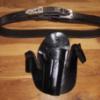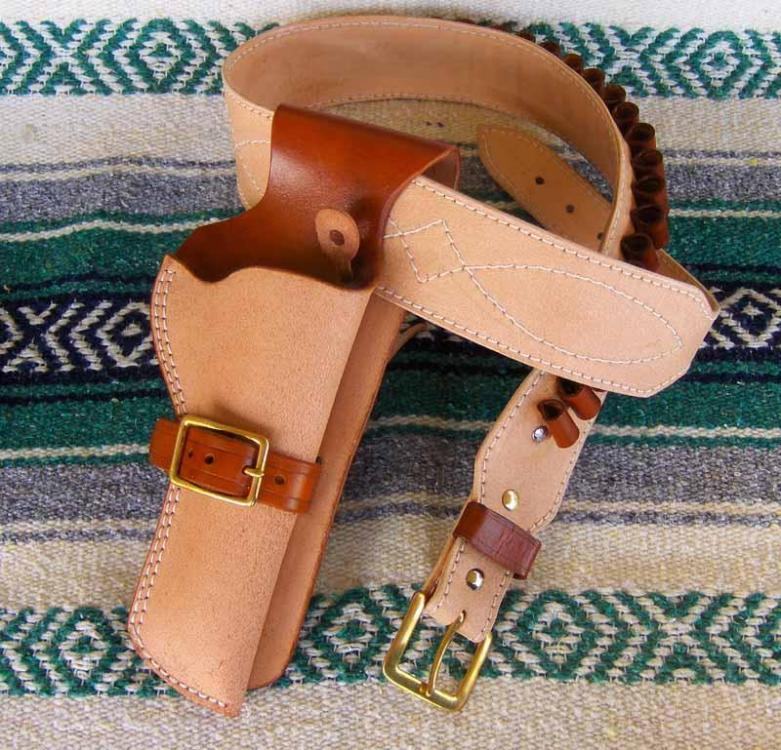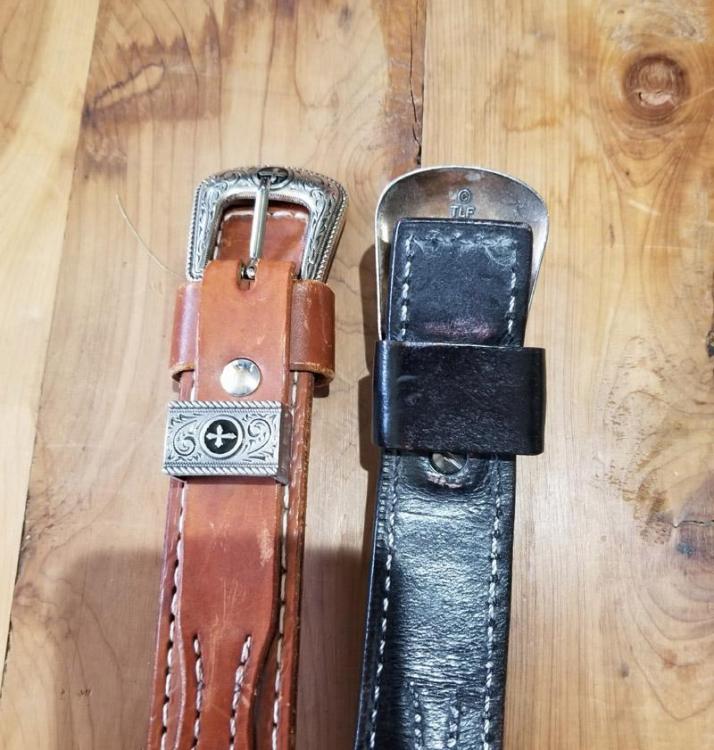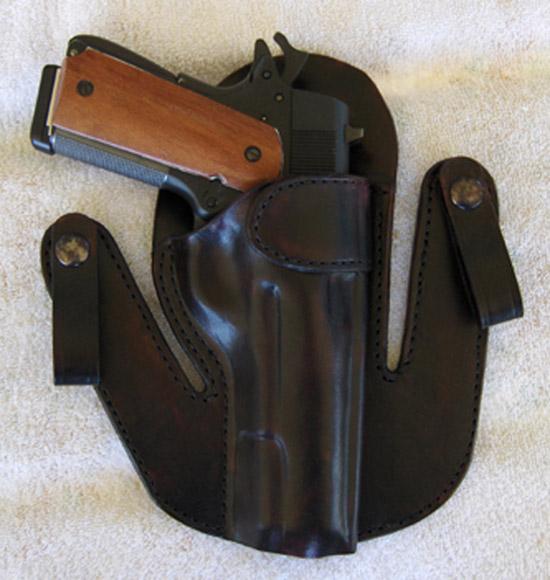-
Posts
5,198 -
Joined
-
Last visited
Content Type
Profiles
Forums
Events
Blogs
Gallery
Everything posted by Dwight
-
Without a special machine, . . . I think they call it a patcher . . . it ain't gonna happen unless you have another seam behind your strap that we cannot see. The other alternative would be (what I would do) to hand sew it. Make a dowel that fits inside it quite nicely . . . use it to back up your punch going thru the leather . . . practice on some cheap belly leather first, till you get your procedure down. For me it would be a 2 hour project (the stitching that is). May God bless, Dwight
-
Biggest problem I've ever found is finding just the "right" piece of leather so it looks good. Inspect it real good . . . then go for it. I've made any number of em . . . pretty much always liked the end result. BUT . . . I cannot think of but one I always do that way . . . if I make one similar to Clint Eastwood's spaghetti western rig . . . Otherwise . . . they are all CCW holsters. The rough texture keeps it from moving around as much . . . and while some folks like that . . . I am NOT a fan of it. Personal choice. May God bless, Dwight
-

My first westernrigg
Dwight replied to caperseven's topic in Gun Holsters, Rifle Slings and Knife Sheathes
Ya got my vote for good lookin, . . . May God bless, Dwight -
Hey, bcraig, . . . there is a holster originated as a driver's self defense holster . . . it's called a "Carjacker". See the video here: The part you want to see mostly is about 2 minutes into it, . . . the two guys are talking about it, . . . and the wearer un-snaps it and takes it off his belt . . . showing you the back side of it and how the two snaps keeps it on your belt at the appropriate angle. I've made a couple of them . . . may still have my pattern somewhere . . . don't recall the gun it was for though. If you are interested in this . . . you can either buy one from the maker as his info is on the video . . . or PM me and I'll see if I can scrounge up the pattern I have. But to answer a few of your questions: I would use 7/8 leather . . . you can probably buy a small single shoulder . . . it is good leather for that type weapon . . . and should give you plenty enough leather for your project . . . and dollar wise I wouldn't think it would be much more (if any more) than some pre-cut piece you would buy. This holster needs enough leather to wrap around your weapon twice and have a good 2 inches extra in length. Yes . . . do a really tight wet mold . . . let it totally, completely, thoroughly get dried out . . . assemble and sew that dude . . . use only the short welt you can see in the video . . . add a retention screw . . . should be plenty good on retention. May God bless, Dwight
-

Shoulder or Bends for Holsters
Dwight replied to caressofsteel's topic in Gun Holsters, Rifle Slings and Knife Sheathes
I generally buy both double shoulders and sides. Shoulders are for holsters, . . . has worked the best for me for 15 or so years. But to each his own. May God bless, Dwight -
You might just wet mold that flap under your thumb, . . . mold it around the phone, . . . tuck the little sucker down inside . . . be surprised how well it just might work. See the one above ^^^^^^^
-
I long, long ago gave up screwing around with fasteners for cell phones. Too easy to make this one, . . . works like a champ, . . . 7/8 oz leather, . . . metal belt snap on the back . . . held together with rivets. This one holds a samsung note 8 with it's kinda rubber like case around it, . . . I wear it in/on the computer chair, . . . dinner table, . . . tractor, . . . zero turn, . . . quad, . . . Jeep . . . van . . . up & down ladders . . . never dropped a phone out of it yet . . . May God bless, Dwight
-

A modern holster for one of my guns
Dwight replied to AzShooter's topic in Gun Holsters, Rifle Slings and Knife Sheathes
Years ago, . . . I made one for a guy . . . had a Ruger .22 with a scope on top. The gun sat vertical in the holster, . . . I used stacked layers of leather that wound up 3/4 of an inch thick . It rested on the front of the trigger guard, . . . the front 3 inches or maybe less covered the muzzle of the gun . . . and it had a suicide strap to keep the gun in place. It was a sale thru a gun shop, . . . never met the customer . . . but the folks at the LGS said he loved it. But I like the thinking out of the box you did on this one . . . bet you get smiles and inquisitive looks wherever you carry it. May God bless, Dwight -
Gotta say "Nahhhh" to the tuckable Idea, . . . I make em . . . and use em . . . reaching to un-tuck with the cell phone in the way . . . Rx for disaster. IWB pancake with a tongue going over the belt. . . . being the case for the cell phone, . . . that'll work . . . even make a loop behind the cell phone for the belt to go thru, . . . might be able to get away with no snaps or loops on the actual holster itself. Might actually turn out to be a hit. Go for it. May God bless, Dwight
-
That's what I'd do.........
-
The navy colored piece, . . . the inner one, . . . definitely is a wet mold I would bet. It is then placed in a two piece wooden mold and partially dried in it, . . . and removed for finish drying, . . . Then the two pieces are dyed, . . . cemented together, . . . edged, . . . and sewn. Quite a bit of work for a place to park an ink pen, . . . May God bless, Dwight
-

Creasing vs stitch grooving
Dwight replied to Scootch's topic in Gun Holsters, Rifle Slings and Knife Sheathes
I sew with a Tippmann Boss, . . . using 346 thread for 99% of what I do. I stitch groove just about all of it, . . . it puts my stitches even with or below the edge of the finished leather, . . . making it much harder to abrade my stitches. But other folks do other things for other reasons. Those are mine. May God bless, Dwight -
Couple of problems I see, . . . and not trying to be offensive, . . . but you are trying to be cheap, . . . and cheap usually equates to low quality. 1. When you dilute the dye, . . . use Feibings reducer, . . . and only go one to one, . . . not one to three. 2. For small projects like wallets and belts and holsters, . . . find a metal pan and "dip dye" the leather. Your sponge marks are perfectly legible on both pieces, . . . some had dye, . . . some were dry, . . . and you got streaks for your effort. 3. On lighter tan and brown especially, . . . always give it a light coat of neatsfoot oil about 24 hours before dying. Let the leather return to the original color, . . . that tells you it is evenly distributed within the leather, . . . and only put the oil on the hair side of the leather. I've done it this way for almost 15 years, . . . and the only time I ever had a hiccup on dying was when an acquaintance said he was having really good results using water as a thinning agent. I won't go into the gory details, . . . enough to say I tossed the project after the dye job, . . . and went back to Feibings reducer. May God bless, Dwight
-
I made a few Kydex holsters, . . . basically soften / melt the plastic in a sheet and drop it on top of the gun or mold, . . . it something near instantly hardens and then you simply take a pair of shears, . . . cut off the excess, . . . sand the edges, . . . put it together. I'm sure that in time, making a number of holsters in kydex would affect the blue mold as it is plastic as well. I began this leather holster stuff back years ago, . . . just got kinda serious about it in '05 or '06. None of my blue guns have ever let me down in the detail, etc. May God bless, Dwight
-
Blue guns have served me quite well for over 10 years. May God bless, Dwight
-
No . . . do not use full strength. And don't do like some folks here . . . don't dilute Pro Dye with water. Feibings makes a thinner . . . use it. Thin the dye 50/50. I pour the dye out of the 4 oz bottle, . . . into a larger container . . . then pour the thinner into the dye jar and swish it around to collect all the surface dye off the inside of the bottle. I then pour the thinner in with the dye . . . shake it good . . . you then have 8 oz of dye that will do the job. Been doing it that way for over 10 years . . . never had a problem but one time . . . tried the suggestion of using water as a thinner . . . was one of the dumbest things I've done in the last 20 years. May God bless, Dwight
-

Need to reproduce a piece...use Resin, 3D printer, etc...
Dwight replied to Historicalbeltworks's topic in How Do I Do That?
I have a couple of "customers" for whom I make key fobs. I sent to China, . . . had brass stamps made . . . they work very well . . . the detail is beautiful . . . and the price was reasonable, even though it took almost 6 weeks to get them. There are folks here in the states who may make you a stamp for a reasonable price. May God bless, Dwight -
Leather breathes, . . . and if water gets in it, . . . eventually it will dry out. Some synthetics can hold water and cause the knife to rust. Seeing the client is looking to protect his knife, . . . kydex is the best choice for THAT, . . . even if you cannot sew it. AND, . . . it can be riveted with only a few rivets. May God bless, Dwight
- 15 replies
-
- synthetic
- knife sheath
-
(and 2 more)
Tagged with:
-
Kydex would be my first choice, . . . I don't like working with it, . . . but it makes a good product when it is done. May God bless, Dwight
- 15 replies
-
- synthetic
- knife sheath
-
(and 2 more)
Tagged with:
-

Is conditioning necessary
Dwight replied to DaveP's topic in Dyes, Antiques, Stains, Glues, Waxes, Finishes and Conditioners.
Fredk's experience has not been the same as mine. Resolene is an acrylic finish, . . . in a common word, . . . plastic. If it is applied correctly, . . . it will totally cover and encapsulate the product. Think of putting something in a plastic bottle, . . . sealing it up, . . . then try to get it wet or dry, . . . See the problem??? If you want to condition and have it work 99% of the time like it should, . . . when you cut your blanks, . . . or at the latest when the item is getting ready for dye, . . . give it a light coat of neatsfoot oil with a bristle brush, . . . I only coat the hair side if I can reach it, . . . if not, where I cannot, I'll coat the flesh side, . . . but it is done sparingly because the flesh side will soak up the oil really quick and will take a lot of it. This will also tend to smooth out the color of especially light browns like Feibings Saddle tan. May God bless, Dwight -
Here is my brown one and my black one. The pictures probably tell you ore about it than I could write in a week. May God bless, Dwight
-
I'm with Frodo, . . . two layers of 7/8 oz, . . . sometimes I'll shave one down so that the overall thickness is .200 or so. As far as the overlap, . . . you want the piece in your right hand to go under the part in your left hand, . . . and slip into a loop on the back of the belt, . . . so it stays even when you cinch it up. Cheap skates making Ranger belts leave the loop off of the back thinking they are saving something, . . . and it ruins the whole look of the belt if the wearer has it in the first or second hole. Looks like a leather tow rope holding his gut in. May God bless, Dwight
-

Why the Rabbit Ears
Dwight replied to LiftPig's topic in Gun Holsters, Rifle Slings and Knife Sheathes
Actually the loops and the belt are a very small part of the picture. They are much more for allowing the holster to be hidden by tucking in the shirt around the holster. May God bless, Dwight -
I kept trying to figure out why my sound wasn't working. One way or another, . . . I kinda shut it down in the late evening when the Mrs is in bed, . . . thought I'd really done it this time, . . . Finally figured there must not be a sound track. Anyway, . . . I figured it out without the play by play. Thanks, may God bless, Dwight
-
Ummm, . . . no sound . . . May God bless, Dwight








